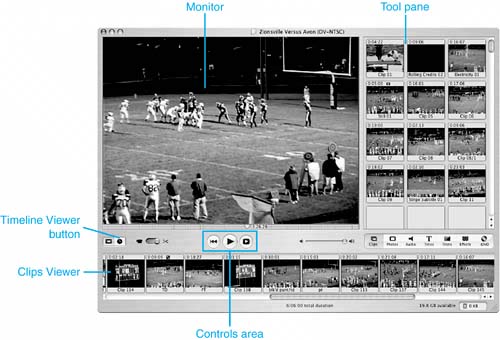Touring iMovie
|
|
| iMovie is part of the Apple iLife suite of applications. To use iMovie, you need to obtain and install the iLife suite (see the following sidebar).
The iMovie window contains five main areas, only four of which you can see at the same time (see Figure 24.1). Figure 24.1. The iMovie window has several areas that perform different functions. The largest pane in the iMovie window is the Monitor. Here, you preview and edit your movie, as well as the clips from which you build that movie. In the upper-right corner is the iMovie Tool pane. At the bottom of the Tool pane are seven buttons, with each button opening a palette of tools in the pane. Just under the Monitor is the controls area that includes various buttons you use to control playback and editing functions. Underneath that area are the two viewers, the Clip Viewer and the Timeline Viewer (you can see only one viewer at a time). In the lower-right corner of the window are the disk space tools you use to manage the disk space associated with your project. iMovie has two basic modes in which you operate: Camera and Edit. The mode you are in is determined by the position of the Camera/Edit mode switch located in the Controls area (refer to Figure 24.1). When the switch is to the left (toward the camera icon), iMovie is in the Camera mode. In this mode, you work with a DV camera attached to your Mac to import video clips from which you will build your movie. When the switch is to the right (toward the scissors icon), iMovie is in the Edit mode and you can work with video clips to preview them, edit them, and so on. You will spend most of your iMovie time in Edit mode. |
|
|
EAN: 2147483647
Pages: 317